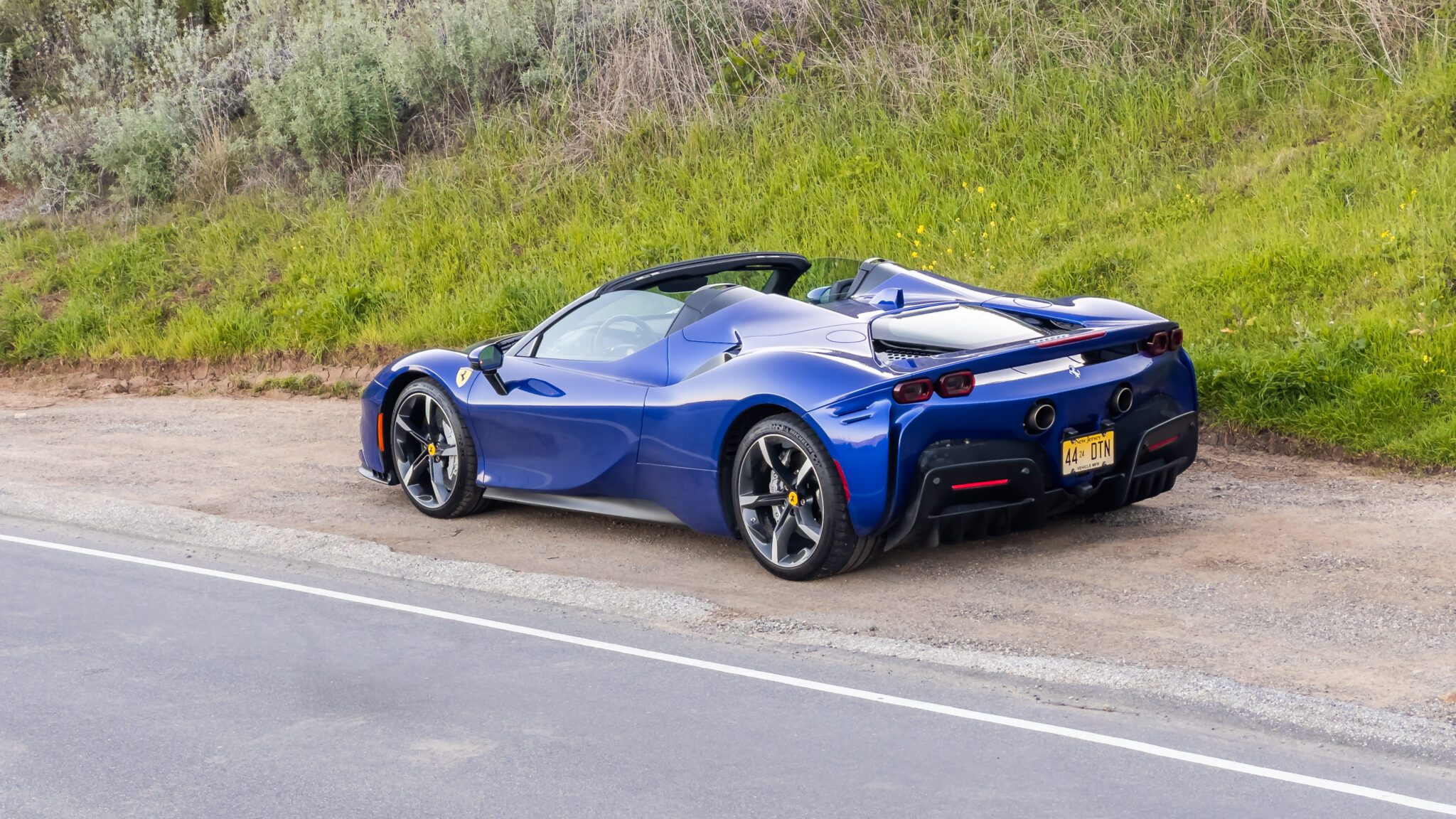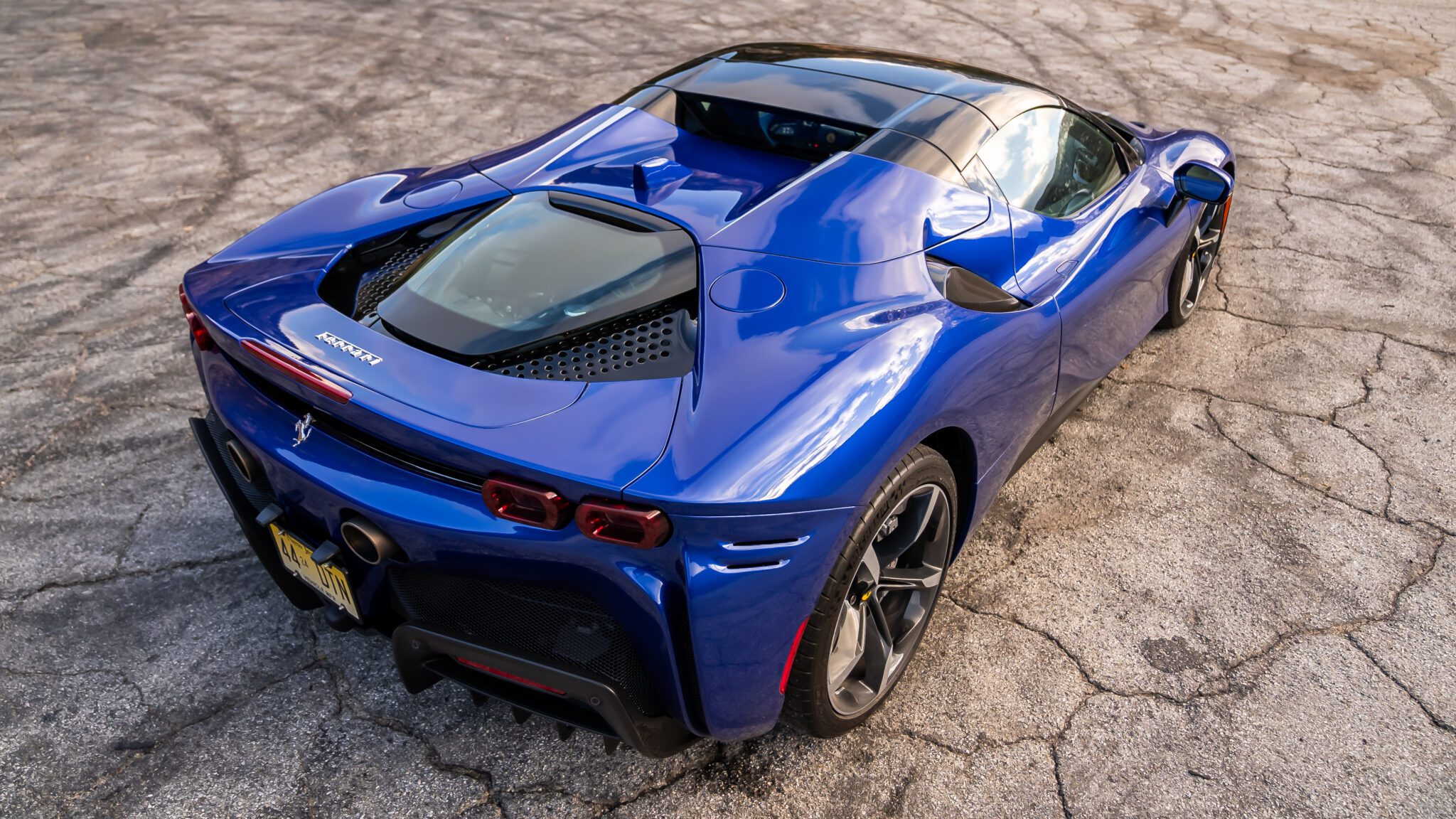Review: The Ferrari SF90 Spider

[ad_1]
The Ferrari SF90 Spider is a car built to accomplish a near-impossible task. On the one hand, it’s a plug-in hybrid saddled with the arduous job of integrating a 4.0-liter twin-turbocharged V8 with no less than three electric motors (two in its front axle and one wedged between its engine and eight-speed dual-clutch transmission). On the other, it’s a convertible with a folding hard top and an intricate mechanism that stows it in 14 seconds. And we have yet to mention its electric driving capabilities, the complexity of its software, which balances performance and battery regeneration, or how its bodywork is littered with clever aero elements hiding in plain sight.
Yet what’s most impressive about the SF90 isn’t its complexity. It’s how each system combines to distill a 986-horsepower supercar into something practically anyone can confidently hustle up a twisty mountain road. In all complex modern sports cars, there’s a point in which the computer magic creates a barrier that prevents the driver from connecting emotionally with even the quickest machine. A $659,101 exotic should deliver a perfect balance of speed and excitement. That is the sweet spot that the Ferrari SF90 Spider seeks to find.

On paper, the Ferrari SF90 Spider’s looks like a supersized F8 Tributo—and not as immediately alluring as a Ferrari of this caliber perhaps should. See it in person, however, and its curvy bodywork, sweeping lines, and intricacy of its many intakes and vents bring its design to life. Although its 78-inch width matches that of the aforementioned F8, it’s three inches longer at 185 inches and an inch lower at 48 inches, giving what is already quite a large two-door a low, wide, and imposing stance.
Unlike the towering rear wing on the SF90 XX, the Spider’s aero elements are far more understated. Take a closer look at its 20-inch wheels and twisting spokes, and you’ll find winglets between them that help channel air as it leaves the wheel well. Ferrari redesigned the Stradale’s brake cooling system with new intakes and an updated brake caliper design. Vortex generators sit nestled beneath its front bumper, while an active flap in its rear decklid closes the open space between its quad tail lights, improving downforce and balance at higher speeds. Opt for the track-focused Assetto Fiorano package, and the SF90 Spider can generate up to 860 pounds of downforce at 155 mph. Our tester wore Michelin Pilot Sport Cup 2 tires measuring 255/35 up front and 315/30 in the rear.

With its retractable hard top in place, it’s nearly impossible to distinguish the Spider from the Stradale. Although its larger rear window, distinct buttresses, and revised decklid hint at a folding mechanism hidden beneath its bodywork, the Spider retains the coupe’s glass engine cover, just with added louvers for additional cooling.
As impressive as the engineering behind the SF90’s design is, a supercar that pushes this many technological boundaries shouldn’t require a closer look. If anything, the XX highlights just how much Ferrari left on the table from an aesthetic perspective. This is, after all, a 986-horsepower hybrid supercar, a car subtlety should be anything but synonymous with.

The Ferrari SF90 Spider’s powertrain kicks engineering complexity into the stratosphere. A 4.0-liter twin-turbocharged V8 serves as its foundation, generating 769 horsepower and 590 pound-feet of torque. That’s 59 hp more than any other V8 Ferrari, an increase made possible by a redesigned intake and exhaust system. Up front, two electric motors make up its RAC-e (Cornering Angle Regulator, Electric) system, which produces up to 217 hp and allows the SF90 to cruise on electrons for up to 15 miles. A third electric motor, MGUK (Motor Generator Unit, Kinetic), sits between its engine and transmission, bringing this Spider’s total system output up to 986 horsepower.
An eight-speed dual-clutch transmission, which debuted in the SF90 Stradale but has now made its way into the Roma and 296GTB, sends power to the back wheels as the RAC-e puts power down upfront while allowing for true torque vectoring. The transmission itself is 20 percent smaller and 22 pounds lighter than the seven-speed unit it replaces despite being able to transmit more torque, thanks in part to more robust clutches.

The software that allows these systems to function harmoniously is almost more complicated than the hardware it commands. Like all modern Ferraris, the SF90 sports a Manettino on its steering wheel, allowing its driver to cycle between Wet, Sport, and Race modes. However, it’s the first Prancing Horse to feature an eManettino, a separate row of touch capacitive buttons that determine how and when it’ll switch from electric to hybrid mode. In the latter, it’s pre-programmed to draw power from the internal combustion engine and regenerative braking system to recharge the onboard 7.9-kilowatt-hour battery.
E-Drive is the SF90’s fully electric mode, which allows it to cruise at up to 84 mph, however, push the accelerator, and the V8 will kick in. Despite allowing for silent driving, this Spider won’t start in electric-only mode if the engine is cold. Additionally, it’ll automatically switch back to the aforementioned hybrid setting once the battery is fully used up. Click up to Performance mode, and its turbo-eight stays engaged, continuously charging its battery and delivering more power. This powertrain’s most aggressive setting is the top Qualifying mode, the only one in which the SF90 delivers its maximum output by drawing power from its engine and electric motors without charging its battery. Once the pack is fully drained, it’ll route engine power to charge it back up.

In Qualifying mode with a topped-up battery and 98 octane fuel, it’ll sprint to 62 mph in 2.5 seconds, to 124 mph in seven, and reach a top speed of 211 mph. However, while these figures are undoubtedly impressive, they fail to convey the tremendous pace the SF90 Spider is capable of in practically any scenario. Thanks to its responsive V8 aided by a rapid transmission and instant torque from its electric motors, its acceleration is so aggressive and instantaneous that one has to recalibrate one’s perception of how fast a supercar can be.
The Ferrari SF90 Spider feels as quick on the road as any hypercar we’ve reviewed thus far, including those costing deep into the seven-figure range. Yet this is simultaneously one of its most significant limitations. Although it seems counterintuitive to critique the best student in the class for getting the most correct answers, the unfortunate reality is that few, if any, roads allow for the full deployment of this car’s outrageous capabilities, a shame considering Ferrari’s turbo-eight howls as it reaches its over 8,000 rpm redline thanks to a brand new dual-exit exhaust system.

It’s a similar story when we look at how the SF90 tackles a twisty road. It is eerily balanced, even in the tightest bends, with tremendous levels of grip. In part, we have its front axle’s torque vectoring system to thank, as well as its adaptive dampers and well-calibrated traction control system. Turn the wheel, and you’re met with ultra-quick, precise, and nicely weighted steering. However, as the nose bites into the entry of a corner, there’s an unshakable sense that computer systems are doing the grunt of the work. It’s as if the car has taken care of everything, and you, the driver, are just along for the ride. The smartest kid in the class strikes again.
Significant direction changes require the subtlest of steering inputs, with instant results. Its standard carbon-ceramic brakes, measuring 15.6 and 14.1 inches front to back, are intuitive with a firm initial bite and progressive pedal travel. Despite the SF90 Spider weighing around 220 pounds over its coupe counterpart and its claimed hefty 3,682-pound dry weight, the proficiency of its traction systems, suspension, and the stiffness of its chassis leave no noticeable loss in performance when compared to the Stradale.

Even as you flip through its drive modes, there’s no unsettling the SF90. It’s not the car that’ll play around and make you feel like a backroad hero with easily managed slides. Its grip levels are so high, and its chassis so dialed in that its only purpose is tackling a road as quickly as possible, even if it comes at the cost of driver engagement.
While the Ferrari SF90 Spider is as fast as any road car can be on a back road, it doubles as an excellent cruiser. Lower its top, set its dampers to their softest setting, and its powertrain settles nicely on longer drives. Although reports of SF90s struggling when transitioning from electric to hybrid power were plentiful when launched, we didn’t experience that during our time on the road. Instead, our tester switched between its modes effortlessly, making it far more usable than just on back road blasts.


Like practically all new Ferrari models, the SF90 Spider’s interior counts on no analog gauges. Instead, it utilizes touch capacitive buttons almost exclusively, which are, unfortunately, less than user-friendly and often require multiple presses to activate. Usability issues aside, its infotainment system is nicely laid out with intuitive menus and, in the case of our tester, a sleek passenger display. A bonus of this supercar’s large footprint is its ample cabin space. However, its cargo volume, on the other hand, is a tiny 3.31 cubic feet, including the area surrounding its seats.
For 2024, the Ferrari SF90 Spider starts at $583,590, while its coupe counterpart costs $528,764. Our 2022 model-year tester carries an as-tested price of $659,101.

The Ferrari SF90 Spider is one of the most complex road cars ever made. From its twin-turbo V8 and tri-motor powertrain to the breadth of its software-enabled capabilities down to its cleverly sculpted bodywork and hidden aero components, it is a true feat of engineering. Shifting emissions regulations have not only pushed supercar brands to embrace hybridization, but they’ve also allowed them to redefine themselves.
In the SF90’s case, Ferrari flexes its engineering muscles, showcasing how advanced its cars can be. Even in Spider form, lugging around an extra 220 pounds, its hypercar hunter is one of the quickest, most intuitive, and easy-to-use road cars. However, in this approach, we reach a point in which technology supersedes driver involvement and enjoyment, and the SF90 uses its advanced tech solely for the pursuit of speed.
[ad_2]